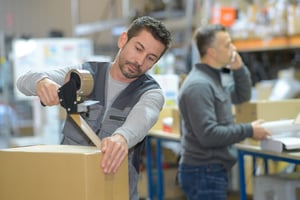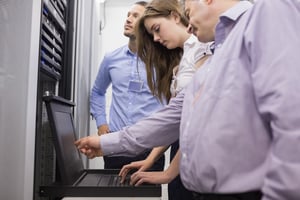Modern Workplace Security Protects Personnel, Property and Information
Modern workplace security must keep your physical assets, your people and your data safe from constant attack.
Why workplace physical security is vital to protect your people, your assets and your intellectual property.
Whenever we talk about security in the workplace these days, there are two main forms of security that rise quickly to the top of the discussion. One is network and data security. Do your IT people know enough to keep your data safe from hackers and prying eyes? The other is physical security. What are you doing to keep your people and your property safe? Physical security is the backbone of both types of security.
Physical security is pretty much exactly what it sounds like; it is the systems used to secure physical space and assets. Physical security encompasses the things employees and guests actually physically touch and the people themselves. Do the right people have access? Are unauthorized people prevented from getting access?
The idea of focusing on workplace security is to lessen the probability of physical harm coming to people, property, and information. While your network security protects data from being accessed remotely, data is just as likely to be compromised in a physical way.
Organizations of all shapes and sizes need to consider their physical security. From the largest to the smallest, they all have something to protect. The primary assets organizations are protecting are:
All of the physical assets your organization owns are your property, and your property is important. You depend on your property in a number of different ways, depending on the type of organization you are.
 You Sell It
You Sell ItIf you work in manufacturing or in some form of retail, it is likely you have inventory ready to be shipped or sold. If this inventory gets damaged or stolen, your profits are out the window.
Even if the products are not ready yet, raw materials are also valuable and, if damaged, maybe unusable and hurt production. Wholesalers sit on warehouses of inventory, and Etsy sellers have their own stashes of raw materials – from yarn to wood to fabric to metal – waiting to be turned into something amazing to sell.
Even the smallest organizations have equipment that they rely on and supplies they need to do their work. Think of all the physical objects offices use every day:
Consider the things factories, auto shops, and medical facilities have
All of the physical things in your environment that keep you safe and comfortable are property, too.
Now think of your workplace without some or all of these things. If your inventory is gone, you now have the hassle of filing an insurance claim – assuming you have insurance – and reordering/recreating your inventory, possibly at a loss.
Maybe you’ve had the experience of coming to work and the copy machine or printer is down. Or your computer is on the fritz. Computer downtime costs businesses $1.5million annually. You have to stop working and spend unproductive time waiting for it to get fixed. If your electronic equipment or furniture were damaged or stolen, you’d be in a bind. Imagine someone came in and stole all the office supplies and the toilet paper as a prank. Not only would you be unable to work, the cost in money and time to replace it all is frustrating.
If someone damages the building, sabotages the HVAC system and it is now stifling hot, there is a cost associated with fixing it. Even if you are a small organization and the building itself isn’t yours – maybe the furniture and computers aren’t even yours! - you’d still want it protected because it is how you do your work. You lose productivity if your employees are uncomfortable or are in any way hampered in doing their jobs.

Your employees are your most valuable asset. Work would grind to a halt without them. The knowledge and skills they possess are not always easily replaceable. And while it shouldn’t have to be said, we’ll say it; they are people. They are human beings. Keeping them safe should be a top priority.
Certain workers are more likely to experience violence at work. These include those who:
Violence isn’t the only thing to be concerned about, though it is the first thing that often comes to mind when people are thinking about workplace security. Security and safety go hand-in-hand. Some organizations have hazardous materials on site that should only be handled by experts. Others have heavy equipment that could easily injure a person while it is in use.
Even those who work in offices likely have rooms full of cleaning chemicals, HVAC equipment or other equipment that come with their own sets of risks. There might be equipment sheds on site that contain snow plows, lawn mowers and hedge trimmers. Trying to use a piece of equipment they don’t know how to use could result in injury.
Securing the premises from vandals and thieves is also a way of protecting employees. If someone damages property or ransacks the office to steal something valuable, employees may get injured in the process. Even if no one is at work at the time of the destruction, think of the hazards that might be left behind when employees return to work. Broken glass, overturned furniture and slippery floors leave your employees at risk for injury.
While most people often do not consider data and intellectual property to be physical assets, they can certainly be accessed physically, and therefore stolen in such a manner. They also happen to be vulnerable to theft and destruction via remote access, which is why so much attention is paid to internet and network security.
 However, data is just as likely to be stolen via the old school method of obtaining it in person, even dumpster diving. There are multiple ways this can occur.
However, data is just as likely to be stolen via the old school method of obtaining it in person, even dumpster diving. There are multiple ways this can occur.
There are multiple ways to work to secure the premises and be proactive about security and safety. Not all of these will be appropriate for all organizations.
The strategies for protecting people and for protecting property are often very similar.
Security is often incredibly noticeable at larger companies and organizations. These are the organizations that hire security guards, have cameras in every corridor, and have electronic door locks everywhere. But what about the small ones?
In some ways, a small organization may need to be even more security conscious than a large organization. Even if they cannot afford to have the latest security gadgets and hire security staff, security still needs to be foremost in their minds. Why?
Unlike a large organization that has some margin to absorb losses, small organizations often don’t. If inventory gets lost or stolen, it can be a major setback to a small business. Damaged buildings and equipment could mean weeks of lost productivity. And if an employee gets injured during a robbery – or fired because they commit the offense themselves – not only does the company have to make up for the loss of the stolen items, but it also loses the time and productivity of that employee.
While small organizations may not be able to purchase expensive security equipment, they can take the time to put less expensive security protocols in place. Things like a single camera, access control of some kind (even via lock and key), a visitor registration system, employee training, and security protocols are all relatively affordable ways to help keep the organization secure.
Organizations that don’t own their own buildings, but rather rent, might take the time to ask their proprietors what sort of security options are onsite.
Every organization, from large to small, needs to have physical security as part of its culture. It can’t be an afterthought. The safety of your people and the success of your organization may very well depend on the security measures that are put in place.
Modern workplace security must keep your physical assets, your people and your data safe from constant attack.
Both physical and data security are necessary for modern office productivity. This article covers an overview of workplace security and how to get...
Every workplace needs to consider workplace security to protect its people, physical items and to avoid possible data breaches.